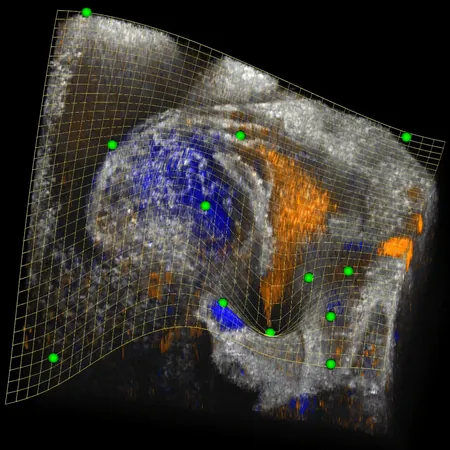
Groundbreaking Software Tool Transforms 3D Imaging in Biomedical Research
2025-01-13
Author: Jia
Groundbreaking Software Tool Transforms 3D Imaging in Biomedical Research
In an exciting advancement in biomedical imaging, researchers have unveiled a revolutionary software tool that enables unparalleled exploration of 3D images. This innovative tool, known as the "clipping spline," provides dynamic cutaway views, revealing intricate dynamics of embryonic mouse heart development through optical coherence tomography (OCT) images.
Shang Wang, leader of the research team at Stevens Institute of Technology, emphasized the importance of this development, stating, "Understanding heart development could play a crucial role in addressing congenital heart diseases, which are the leading cause of birth defects." He also noted the potential implications for regenerating heart tissue after damage from a heart attack, signaling a significant leap in cardiac therapies.
The details of this cutting-edge tool are published in *Biomedical Optics Express*. The clipping spline is an open-source, user-friendly application designed to visualize complex 3D structures—such as the curvilinear anatomy of the heart—in a single, coherent cutaway view. This innovation not only enhances biological research but also has promising applications in clinical medicine.
Andre Faubert, a research associate in Wang's lab, described the potential of 3D imaging, stating, "While 3D imaging is already vital in biomedicine, the temporal aspect often goes overlooked. By considering it as a 4D image, we unlock new understanding." The researchers demonstrated the clipping spline using 4D OCT data, showcasing its versatility across various imaging modalities.
Inside the Heart's Development
The team initially developed the clipping spline to probe heart development during critical stages known as "cardiac looping," where the heart tube contorts into complex shapes that are crucial for proper blood flow. "This looping stage is pivotal to heart development and is linked to numerous congenital defects," said Wang. Despite its significance, little was known about its underlying dynamics—until now.
To address this, the researchers utilized volume clipping, a computational technique that removes certain voxels from 3D images to reveal internal structures. Traditional methods typically employ straight clipping planes, which limit visualization capabilities. The clipping spline circumvents these issues by using a mathematical construct called the thin plate spline (TPS), permitting the creation of complex, adaptable surfaces that can smoothly follow the contours of intricate anatomical structures.
This adaptive technology provides real-time adjustments to cutaway views, enhancing researchers' ability to analyze developmental anomalies in the heart. The researchers successfully tracked myocardial dynamics in mouse embryos over an extensive 12.8-hour period, capturing their behavior across 712 distinct time points. This comprehensive analysis revealed unprecedented insights into the heart's biomechanics and blood flow patterns.
Implications for Future Research
The potential applications of the clipping spline extend beyond heart development. Wang expressed excitement about the broader implications of their research, stating, "Understanding biological development is not only crucial for managing congenital diseases but also lays the groundwork for significant advances in other fields, such as cancer research and regenerative medicine."
Ready for widespread implementation, the clipping spline is set to make waves in the biomedical imaging community. Researchers are now poised to refine the tool further while exploring its capabilities in other areas of biological investigation.
The combination of cutting-edge imaging and interactive visualization paves the way for deeper insights into the fundamental processes of development, offering hope for significant advancements in health outcomes. As they continue their work, the team remains committed to enhancing our understanding of how complex biological systems, like the heart, develop and function.







 Brasil (PT)
Brasil (PT)
 Canada (EN)
Canada (EN)
 Chile (ES)
Chile (ES)
 Česko (CS)
Česko (CS)
 대한민국 (KO)
대한민국 (KO)
 España (ES)
España (ES)
 France (FR)
France (FR)
 Hong Kong (EN)
Hong Kong (EN)
 Italia (IT)
Italia (IT)
 日本 (JA)
日本 (JA)
 Magyarország (HU)
Magyarország (HU)
 Norge (NO)
Norge (NO)
 Polska (PL)
Polska (PL)
 Schweiz (DE)
Schweiz (DE)
 Singapore (EN)
Singapore (EN)
 Sverige (SV)
Sverige (SV)
 Suomi (FI)
Suomi (FI)
 Türkiye (TR)
Türkiye (TR)
 الإمارات العربية المتحدة (AR)
الإمارات العربية المتحدة (AR)